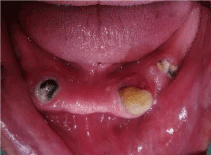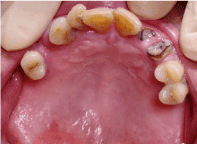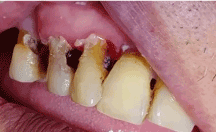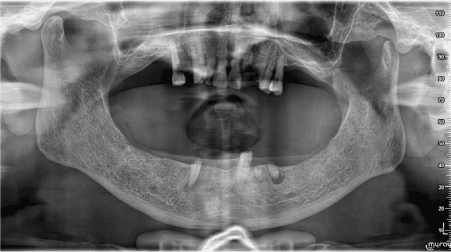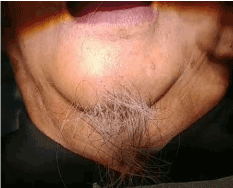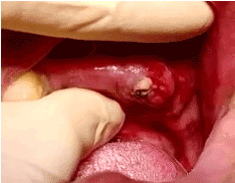Mental stress-induced myocardial ischaemia is a recognized phenomenon in patients with cardiovascular diseases. Ludwig Angina is rapidly progressive and lethal in nature.
This is a case report of a 74-year-old Chinese male with ischaemic heart disease presented with severe dental infection and early signs of Ludwig Angina. The patient underestimated the severity of his own dental condition and was uncooperative. The operator attempted to inform the patient of the consequences of Ludwig Angina progression, but was stopped by the patient’s wife, who insisted that it would cause emotional stress and provoke acute cardiovascular event. Ultimately, the operator complied to the wife’s request of not telling the patient the truth. Extraction of the infected tooth with drainage of pus via socket, antibiotics prescription and close monitoring of the patient were performed. The acute infection eventually subsided, but the patient still had not heard of the term ‘Ludwig Angina’ or how his underestimation of the disease posed a great dilemma to the operator, nor did he come for elimination of other possible sources of infections.
Complicated by patients’ low compliance and downplay of dental infections’ severity, management of Ludwig Angina in patients with cardiovascular diseases is challenging. Clinicians should be ready for encountering these conditions. Dental practitioners should remind patients with cardiovascular diseases to bring along their emergency medications prescribed by their physicians. A balance should be struck between telling the patient the truth and avoiding mental stress-induced myocardial ischemia or other adverse conditions arisen from doing so.
Ludwig Angina, Cardiovascular Disease, Dental Anxiety, Dental Infection, Patient Management
Day 1 (9th September 2017): A 74-year-old Chinese male attended this clinic on 9th September 2017, complaining of extreme pain of the right side of oral cavity. The patient filled out the medical history form that he had high blood pressure, heart disease, diabetes and kidney disease but none of the medications was bought along with him. The operator could not check and confirm the description of diseases with the patient and his wife. The patient was therefore requested to bring along the medication list next time when he came back.
Extraoral examination showed no significant facial asymmetry, facial swelling or palpable lymph nodes. On intraoral examination (Figures 1, 2 & 3), there were five retained roots, including 22 (upper left lateral incisor), 23 (upper left canine), 34 (lower left first premolar), 35 (lower left second premolar) and 43 (lower right canine), with buccal abscesses at 34 and 43 periapical regions. There was also gross caries on 11 (upper right central incisor), 12 (upper right lateral incisor), 13 (upper right canine) and 15 (upper right second premolar). The patient had partial edentulism with only retained roots of 35, 34 and 33 (lower left canine) as well as 43 remained in the lower arch.
Orthopantomogram (Figure 4) revealed four apical radiolucencies respectively at 35, 34 and 33 retained roots as well as 15. Triangular radiolucency on mesial root of 15 extended to root canal. Check
43 retained root with periapical abscess as well as caries on 11, 12, 13 and 15 were possible sources of infection causing pain on patient’s right face. Local anesthesia was performed with 1.7 ml Mepivastesin (3% mepivacaine hydrochloride) by buccal and lingual infiltration at 43. Temporary relief of pain achieved following local anesthesia indicated that infection at 43 was the major source of pain on right face.
Because of patient’s fear of extraction and request for a well-supported denture, root canal treatment of 43 was proposed despite the extreme difficulty and high chance of failure, which were explained to the patient. First phrase treatment planning included root canal treatment of 43, extraction of 34 and 35 retained roots, and lower ball attachment-retained overdenture. Treatment for upper teeth would be planned later. Written information of root canal treatment (Appendix I) was given to the patient, his wife and his son for consideration.
The patient back a few hours later with a medication prescription list. According to the list, the patient had no known drug allergy and was taking medications for ischemic heart disease with long term management of Angina Pectoris and/or heart failure, hypertension, diabetes mellitus, gout and hyperlipidemia currently under treatment at an out-patient medical clinic in Hong Kong (Table 1).
Table 1. A list of medications prescribed by medical clinic to the patient.
1 |
Gliclazide tablet PO 160mg morning and 160mg pm for 16 weeks |
2 |
Nifedipine sustained release tablet PO 20mg bd for 16 weeks |
3 |
Simvastain tablet PO 20mg nocte for 16 weeks |
4 |
Pantoprazole sodium sesquihydrate tablet PO 20mg daily for 16 weeks |
5 |
Aspirin 100mg with glycine 45mg tablet PO 1 tablet daily for 16 weeks |
6 |
Perindopril tertbutylamine (Acertil) tablet PO 2mg daily for 16 weeks |
7 |
Metoprolol tartrate tablet PO 25mg bd for 16 weeks |
8 |
Isosorbide mononitrate (Imdur) controlled release tablet PO 90mg om for 16 weeks |
9 |
Vildagliptin (Galvus) tablet PO 50mg morning for 16 weeks |
10 |
Paracetamol (Panadol) tablet PO 500mg qid prn for 8 weeks |
11 |
Glyceryl trinitrate (TNG) spray 0.4mg/dose 200 doses;
sublingual 1 dose stat prn for 16 weeks |
12 |
Colchicine tablet PO 0.5mg bd prn for 4 weeks |
The patient agreed to the previously proposed treatment plan. Emergency root canal treatment was performed with drainage of pus through root canal obtained. Metronidazole 200mg tds and Augmentin 375mg (amoxicillin 250mg and clavulanic acid 125mg) both for 5 days were prescribed. Paracetamol 500mg qds for 5 days were also given. The patient, his wife and his son were instructed to withhold the paracetamol prescribed by his medical doctor and take the medication given at the clinic instead.
The patient and his wife were advised to inform the operator immediately or seek emergency care at hospital if the patient experienced any persistent pain, swelling or fever. Since the patient’s wife forbade the operator from telling the patient any worrying information of his condition so as not to ‘scare’ him and bring him unbearable stress inducing heart attack, the lethal risk of infection spreading from the periapical region of 43 to the submandibular fascial space was therefore explained to the patient’s son via Whatsapp messages instead.
Day 2 (10th September 2017): The patient, accompanied by his wife, came back 1 day later with complaints of slightly painful swelling of lower right face. On extraoral examination, there was right neck swelling with overlying tenderness and erythema. The swelling and his floor of mouth were painful to palpation. These were the early signs and symptoms of Ludwig Angina.
The operator attempted to explain the diagnosis and its fatal complications to the patient but was again forbidden to do so by his wife who told the operator not to scare the patient as he had heart disease. Therefore, the operator informed his wife face-to-face and his son via Whatsapp messages the patient’s conditions instead.
Due to the uncontrolled spread of infection despite the root canal treatment done on 43 the day before, extraction of 43 was planned and conducted under local anesthesia (1.7ml mepivastesin) by buccal & lingual infiltration. Pus was drained through the socket, the socket was curetted and the mobile wound was stabilized by suture following hemostasis. Post-operative instructions were given verbally and in Chinese written notice (Appendix II). An extra 1-day course of medication including Augmentin 375mg tds, amoxicillin 250mg tds and metronidazole 200mg tds, as well as a 5-day course of lysozyme HCL 20mg tds were prescribed. The patient was asked to take these concurrently with the antibiotics and paracetamol given the day before (Figure 5,6). For close monitoring of the patient’s condition due to the rapidly progressive and lethal natures of Ludwig Angina, the operator advised the patient to stay at the dental clinic for a few hours, yet the patient refused as he wanted to watch horse-racing at home. Thus, the operator instructed the patient to come back 5 hours later for review.
Examination at review revealed reduction of right neck swelling and pain. The patient was requested to come back for review the day after.
Day 3 (11th September 2017): Patient came back for review of the neck swelling and pain. Further reduction (though not yet completely subsiding) of the upper right swelling and pain was observed and wound healing was normal. Prompt extractions of the 34 and 35 retained roots remained and treatment of carious 15, 13, 12 and 11 with options including restorations, root canal treatment or extractions were recommended to eliminate other sources of odontogenic infections. However, the patient did not arrange any further appointment for review or treatment of the remaining infected teeth.
The conditions of Ludwig Angina were first introduced by Karl Friedrich Wilhelm von Ludwig in 1836 as a rapidly progressive cellulitis with soft tissue edema of the neck and floor of mouth [1-3].
Odontogenic infections accounted for a majority of cases, ranging from 70-90 [4-6]. A retrospective review found out that diabetes mellitus (DM) may be a precipitating factor in Ludwig Angina and other deep neck infections [7]. Another retrospective analysis concluded that DM patients showed increased risk of complications of Ludwig Angina including descending mediastinitis, necrotizing fasciitis and death [4].
In patients with Ludwig Angina, edema arising from submandibular fascial space infection displaces the floor of mouth and the tongue supero-posteriorly, resulting in airway obstruction in advanced cases, thus increasing the risk of mortality [7-9].
The patient in this case was presented with multiple retained roots, periapical abscesses and caries, giving rise to multiple sources of infection that may cause Ludwig Angina and potentially other severe complications. His diabetic condition also made him more susceptible to severe and aggressive infections, and in this case, early stage of Ludwig Angina. Therefore, early diagnosis and prompt intervention were of utmost importance in managing this case.
Maintenance of a patent airway [10,11], intensive antibiotics therapy [10-12], elimination of infection origins [11] (e.g. root canal treatment, extraction of the infected tooth) and drainage [10,11] are shown to be essential in the management of Ludwig Angina from literature review and clinical experience.
Close monitoring of the patient’s airway and disease progression is important due to the rapidly progressive and fatal nature of the disease. Management of the patient in this case was however complicated by his underestimation of the dental condition, low compliance and low stress tolerance associated with his ischemic heart disease. Due to his ischemic heart disease, the patient’s wife declined the operator’s attempt to explain and emphasize to him the severity of his dental condition and the signs of early stage of Ludwig Angina as it may scare him and give him unbearable stress leading to heart attack. The patient did not bring along his emergency medication for angina pectoris (glyceryl trinitrate spray) either.
Without informing the patient with details of his early signs of Ludwig Angina, the operator could not convince the patient for referral to hospitalization, which is the routine management. He also refused to stay at the clinic for close observation, making it difficult for the operator to monitor his Ludwig Angina condition.
This posed a dilemma for the operator – should the patient be thoroughly explained to concerning his clinical conditions for a well-informed decision making regarding treatments to be received, or be withheld information from for the sake of preventing acute cardiovascular events triggered by stress?.
Code of Professional Discipline for the Guidance of Dental Practitioners in Hong Kong published by the Dental Council of Hong Kong stated that dentists should provide appropriate information to patients to enable them to make an informed choice and to make the best use of the services the dentist offers [13]. Sullivan et al. showed in a study that the vast majority patients wished to be told of serious, life-threatening diagnoses and that better treatment outcomes are demonstrated in well-informed and actively participating patients [14]. Another study concurred with the result, reporting that the provision of pre-operative information is generally useful in anxiety reduction in oral surgery patients [15].
However, stress and negative emotions are potential psychological triggers of acute cardiovascular events such as myocardial infarction in patients with cardiovascular disease [16-18]. Mental stress-induced myocardial ischaemia is a recognized phenomenon, in which sympathetic activation, increased systemic vascular resistance, coronary constriction and microvascular dysfunction are hypothesized to play an important role in the pathogenesis [19]. Dental anxiety of varying extent is common in patients seeking dental treatment [20]. There were recent incidences in which patients with cardiovascular disease died from myocardial infarction during dental consultation before any treatment was done [21-24]. Therefore, minimizing patient’s stress and anxiety is an important aspect of patient management, especially for patients with cardiovascular diseases.
Without thorough understanding and professional medical input of patient’s cardiovascular condition, input from the patient and his guardians/next of kin are essential. The potential risk suggested by his wife that the patient learning the severity of his own dental condition may pose him stress heavy enough to induce acute cardiovascular event had to be recognized. The patient not bringing any emergency medication for angina to the clinic complicated the management of potential dangerous cardiovascular events such as myocardial infarction and angina pectoris. The operator therefore complied to the wife’s request and decided not to inform the patient of his dental condition.
Only informing the patient’s family of his dental condition would not have been too much of a problem if the patient complied to the treatments proposed by the operator. However, this was hindered by his downplay of the importance of oral health and the severity of oral diseases.
Despite the increased awareness concerning general health, the importance of dental health is often underestimated by the general public especially the older generation. Oral Health Survey 2011 revealed that the majority of the non-institutionalized older population did not have any dental checkup habit, and even with severe sleep-disturbing pain, only about 40% sought care from dentists [25]. Patient’s underestimation of oral diseases, dental anxiety and economic concerns delay or even hinder patients from seeking prompt treatment, not only endangering patients themselves, but also aggravating the burden on dental practitioners.
To modify these behavioral factors, it is crucial for practitioners and the government to instill the importance of oral health maintenance and to advocate regular dental checkups and treatments. Patients’ avoidance of dental treatment due to anxiety and/or economic concerns should also be addressed.
Both Ludwig Angina and cardiovascular diseases are lethal in nature. The operator had to be extremely careful in managing this case. Clinicians should be ready for encountering these conditions. They should remind patients with cardiovascular diseases to bring along their emergency medications prescribed by their physicians. A balance should be struck between telling the patient the truth and avoiding mental stress-induced myocardial ischemia or other adverse conditions arisen from doing so.
Consent of all clinical records including notes, photos video and extracted tooth etc. for teaching, oral health education and research obtained.
None declared. The patient was a new patient in chief author’s private clinic.
View supplementary data
- Young C (2018) Ludwig Angina – To tell or not to tell?. Available at: http://www.h2osteamwatericeforum.com/ludwig-angina-to-tell-or-not-to-tell/. Accessed June 2, 2018.
- Von Ludwig WF (1836) Über eine in neuerer Zeit wiederholt hier vorgekommene Form von Halsentzündung. Medicinisches Correspondenzblatt des Württembergischen ärztlichen Vereins 6: 21–25.
- Burk J, Ludovici A (1939) A translation together with biography of Wilhelm F von Ludwig. Bull Hist Med 7:1115-1126.
- Botha A, Jacobs F, Postma C (2015) Retrospective analysis of etiology and comorbid diseases associated with Ludwig’s Angina. Ann Maxillofac Surg 5: 168-173.
- Sethi DS, Stanley RE (1994) Deep neck abscesses – changing trends. J Laryngol Otol 108: 138-143.
- Bross-Soriano D, Arrieta-Gómez JR, Prado-Calleros H, Schimelmitz-Idi J, Jorba-Basave S (2004) Management of Ludwig’s angina with small neck incisions: 18 Years experience. Otolaryngology – Head and Neck Surgery 130: 712-717.
- Huang TT, Liu TC, Chen PR, Tseng FY, Yeh TH 2021 Copyright OAT. All rights reservof 185 cases. Head Neck 26: 854-860.
- Bradley F, Marple B (1999) A Review of Current Airway Management. Arch Otolaryngol Head Neck Surg 125: 596-599.
- Moreland LW, Corey J, Mckenzie R (1988) Ludwig’s angina: Report of a case and review of the literature. Arch Intern Med 148: 453-456.
- Chou YK, Lee CY, Chao HH (2007) An upper airway obstruction emergency: Ludwig angina. Pediatr Emerg Care 23: 892-896.
- Srirompotong S, Art-Smart T (2003) Ludwig’s angina: A clinical review. Eur Arch Otorhinolaryngol 260: 401-403.
- Pak S, Cha D, Meyer C, Dee C, Fershko A, et al. (2017) Ludwig’s Angina. Cureus 9: 8-11.
- The Dental Council of Hong Hong. Code of Professional Discipline for the Guidance of Dental Practitioners. 2008.
- Sullivan RJ, Menapace LW, White RM, College M, York N (2001) Truth-telling and patient diagnoses. J Med Ethics 27: 192-197.
- Ng SKS, Chau AWL, Leung WK (2004) The effect of pre-operative information in relieving anxiety in oral surgery patients. Community Dent Oral Epidemiol 32: 227-235.
- Mittleman MA, Mostofsky E (2011) Physical, psychological and chemical triggers of acute cardiovascular events: Preventive strategies. Circulation 124: 346-354.
- Nawrot TS, Perez L, Künzli N, Munters E, Nemery B (2011) Public health importance of triggers of myocardial infarction: A comparative risk assessment. Lancet 377: 732-740.
- Wallert J, Held C, Madison G, Olsson EM (2017) Temporal changes in myocardial infarction incidence rates are associated with periods of perceived psychosocial stress: A SWEDEHEART national registry study. Am Heart J 191: 12-20.
- Arri SS, Ryan M, Redwood SR, Marber MS (2016) Mental stress-induced myocardial ischaemia. Heart 102: 472-480.
- Ng SKS, Leung WK (2008) A community study on the relationship of dental anxiety with oral health status and oral health-related quality of life. Community Dent Oral Epidemiol 36: 347-356.
- A Man Died Before The Tooth was Extracted Inside the Clinic. Apple Daily.https://hk.news.appledaily.com/local/daily/article/20100507/14005316. Published May 7, 2010.
- Middle-aged Man Died In The Dental Chair The Sun. http://the-sun.on.cc/cnt/news/20100507/00407_014.html. Published May 7, 2010
- Middle-aged Man Died In The Dental Chair The Sun. https://bit.ly/2sARmfF. Accessed June 2, 2018.
- A man died before the dental extraction in his nephew's dental clinic. Apple dialy.https://bit.ly/2J4Saon. Accessed June 2, 2018.
- Department of Health. Oral Health Survey 2011.

